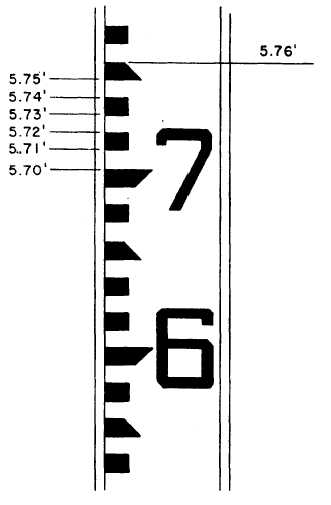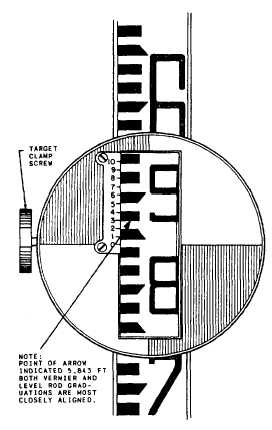Figure 14-8.-Showing a direct reading of 5.76 ft on a
Philadelphia rod.
cross hair. A rod other than an architect’s rod is
usually graduated in feet subdivided to the nearest
0.01 ft; therefore, direct readings are possible only
to the nearest 0.01 ft.
Figure 14-8 shows a direct reading of 5.76 ft
on a Philadelphia rod. You can see that each black
graduation and each white, interval represents 0.01
ft.
You can see also that the black figure 7 is the
only numeral of the reading 5.76 ft that appears
in the view. The red numeral 5 would not be
visible through the telescope unless the sight
distance was quite far away. For this reason, you
would signal the rodman to “raise for red,” as
described in the previous chapter.
To make sure you relate the reading for tenths
and hundredths to the correct whole-foot red
numeral, it is best to make a direct reading as
follows: When the horizontal cross hair and the
rod are brought into clear focus, first determine
the number of hundredths. Then, read the next
lower black figure for the tenths. Finally, signal
for a “raise for red,” and note the number of
whole feet.
Making Target Readings
The three most common situations in which
target readings rather than direct readings are
made are as follows: (1) when the rod is too far
from the instrument to be read directly; (2) when
you desire a reading to the nearest 0.001 ft, which
requires the use of the vernier by the rodman; and
(3) when the instrumentman thinks a reading by
the rodman instead of by himself more likely will
be accurate.
For target readings up to 7.000 ft, the
Philadelphia rod is used fully closed and read on
the face by the rodman. The rodman sets the
target on the face by the signals from the
instrumentman,
who determines when the
horizontal axis of the target intercepts the
horizontal cross hair.
When the instrumentman signals “all right,”
the rodman clamps the target in place with the
target screw clamp, as shown in figure 14-9; then
Figure 14-9.-Target reading of 5.843 ft on a Philadelphia
rod.
14-9




